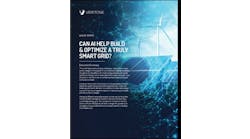Let’s say microgrid developer PowerSecure has been asked to price out the feasibility of a microgrid at a retail grocery store in Wisconsin.
How does the developer go about finding the utility pricing information that will demonstrate that the project is or isn’t financially viable?
The answer isn’t simple, said Brian Knight, structured finance director, PowerSecure.
Finding utility pricing data for such projects is very site specific, given the existence of so many investor-owned utilities, regional transmission operators (RTO) and independent system operators (ISO), he said. There’s no one-size-fits-all solution to finding data. But finding it is critical.
Ken Horne, chief operating officer of Compass Energy, agreed. In order for commercial and industrial utility customers to determine the potential of a third party owned microgrid that would serve them, they have to identify their current and forecasted power bills over the term of the proposed service agreement. Then they need to compare that to the proposed service cost, he said.
Microgrid developers must scrutinize your utility bill
Gregg Morasca, vice president, strategic customers for Schneider Electric, added that the utility bill is a key reference point for understanding the feasibility of a microgrid for a customer and for optimizing the system once it is up and running.
But that research takes time and patience, said PowerSecure’s Knight. To identify the potential financial benefits of a microgrid, PowerSecure begins with the client’s address, researches the local utility rates and uncovers what price signals the utility makes available.
“We go utility by utility and learn about the rules that utility has and see which utility charges we can knock out effectively using a microgrid,” he said.
If the utility doesn’t send the appropriate price signals, the project won’t pencil out, he said.
For example, demand response programs offer important price signals. For many commercial and industrial customers, nearly one-third of the bill translates to how much energy the customer used during the customer’s top —or peak — 15 minutes of the month. “If you have a microgrid robust enough for you to disappear off the grid for those 15 minutes, your utility bill will drop by a third,” he said.
“You have to have employees who can read tariff documents, which are a really bad blend of legalese and engineering and put people to sleep.” — Brian Knight, Powersecure
Many conversations with prospective microgrid customers begin with a look at the utility’s peak periods. To help the customer,PowerSecure identifies the peak periods and the pricing associated with those peaks.
For those operating in In deregulated wholesale markets, it’s important to find out if the RTO or ISO offers demand response or ancillary services programs that provide for the microgrid owner to get paid.
Lost in the mush
In the effort to nail down this information, important data can get “lost in the mush,” Knight said. To ensure that doesn’t happen, his company has researchers who are willing to “call the city of Orange, Florida and go over and review what’s in the tariff document and see if what they say is what they mean.” Without this research, utility tariff confusion can lead to inaccurate financial analyses.
“You have to have employees who can read tariff documents, which are a really bad blend of legalese and engineering and put people to sleep,” Knight said
Horne agreed that rates are complex and customers often don’t understand what they include.
“Generally, commercial and industrial utility bills may be simplistically understood to be comprised of a fixed cost and a variable,” he said.
The fixed cost is the dollars per month that don’t vary as a result of consumption. Variable costs, on the other hand, change either by volume of energy consumed, in dollars per kWh, or by the demand during the highest demand hour of the month or year.
The key, Horne said, is for commercial and industrial customers to understand their current utility bill, and compare that to a possible bill from another source of supply, such as a microgrid.
By EyeLights West/Shutterstock.com
During this process, it’s important to take a look at the customer’s view of future energy use, asking whether it will remain the same, increase or decrease. An additional question is whether the timing of energy use will change. Will the highest demand hour of each month be different in the future?
“Putting this into a financial model that can provide monthly or annual costs for the term of the third party provider agreement for both current utility service and proposed third party service will allow a fair apple-to apple comparison of bottom line costs between the two alternatives,” said Horne.
But utility costs aren’t the only consideration, Horne pointed out. Reliability and resilience are also important factors.
“How much will reliability improve or decline under the proposed third party provider?” he asked.
Making money from microgrids
Potential microgrid builders or hosts should also look at the microgrid’s ability to aggregate and sell project attributes to buyers or markets. Those would include tax attributes or environmental attributes such as renewable energy certificates (REC). Each state has its own renewable energy targets and its own REC market, further complicating the task.
Schneider Electric’s Morasca said that it’s also important to look for and understand time of use rates.
“A variable or time of use (TOU) rate, may also be shifting to evening rates due to an increase of solar in certain areas of the country (addressing the duck curve),” he said. By optimizing batteries and PV, microgrids can capture excess solar during the day and store for use when time of use prices are high.
The microgrid evaluation process should begin with a look at the customer’s annual energy consumption and cost. This bill data, along with the customer’s load profiles for a year — ideally at 15-minute intervals — helps customers and developers understand their seasonal usage.
Historical pricing example, courtesy Clarity Grid
Companies that offer data on price
Several data service companies help developers and utility customers evaluate pricing, among them Clarity Grid Solutions, Genability’s Energy Toolbase, Yes Energy and Genscape/Bloomberg.
However, microgrid developers say that while such data services are helpful, developers don’t — and shouldn’t — rely solely on them.
Kevin Hannon, CEO of Clarity Grid Solutions, said that databases are helpful because many customers don’t understand what costs — other than energy costs — affect their bills.
These costs include ancillary service charges, line losses, capacity charges and the cost of renewable energy, all of which are identified by his company’s database.
To calculate the benefits of distributed energy resources, it’s important to analyze the benefits of a battery. Clarity Grid Solutions in about a month will release a battery calculator that shows utility customers how much they can save using a battery, based on their location and other factors.
For example, if a company thinks it needs a two-hour, 250 kW battery, the database will identify the company’s load profile — including peak energy use — and provide information to determine if that’s the right size.
Whether microgrid developers are sizing batteries, trying to determine how much income a microgrid can earn in markets or calculating savings, they need to remember that each microgrid project is different — and so is the utility data they need to understand.
“Everyone is charged for power differently,” said Powersecure’s Knight. “There are different line items, and they’re a function of which utility or entity you are working with.”
Join the Microgrid Knowledge LinkedIn Group to stay on top of microgrid news and network with others who are interested in microgrids.








